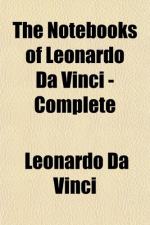Erano i primi tentativi di quella riproduzione immediata delle parti vegetali, che poi sotto il nome d’Impressione Naturale, fu condotta a tanta perfezione in questi ultimi tempi dal signor de Hauer e da altri_.”]
617.
Very excellent will be a stiff white paper, made of the usual mixture and filtered milk of an herb called calves foot; and when this paper is prepared and damped and folded and wrapped up it may be mixed with the mixture and thus left to dry; but if you break it before it is moistened it becomes somewhat like the thin paste called lasagne and you may then damp it and wrap it up and put it in the mixture and leave it to dry; or again this paper may be covered with stiff transparent white and sardonio and then damped so that it may not form angles and then covered up with strong transparent size and as soon as it is firm cut it two fingers, and leave it to dry; again you may make stiff cardboard of sardonio and dry it and then place it between two sheets of papyrus and break it inside with a wooden mallet with a handle and then open it with care holding the lower sheet of paper flat and firm so that the broken pieces be not separated; then have a sheet of paper covered with hot glue and apply it on the top of all these pieces and let them stick fast; then turn it upside down and apply transparent size several times in the spaces between the pieces, each time pouring in first some black and then some stiff white and each time leaving it to dry; then smooth it and polish it.
On the preparation and use of colours (618-627).
618.
To make a fine green take green and mix it with bitumen and you will make the shadows darker. Then, for lighter [shades] green with yellow ochre, and for still lighter green with yellow, and for the high lights pure yellow; then mix green and turmeric together and glaze every thing with it. To make a fine red take cinnabar or red chalk or burnt ochre for the dark shadows and for the lighter ones red chalk and vermilion and for the lights pure vermilion and then glaze with fine lake. To make good oil for painting. One part of oil, one of the first refining and one of the second.
619.
Use black in the shadow, and in the lights white, yellow, green, vermilion and lake. Medium shadows; take the shadow as above and mix it with the flesh tints just alluded to, adding to it a little yellow and a little green and occasionally some lake; for the shadows take green and lake for the middle shades.
[Footnote 618 and 619: If we may judge from the flourishes with which the writing is ornamented these passages must have been written in Leonardo’s youth.]
620.
You can make a fine ochre by the same method as you use to make white.
621.
A FINE YELLOW.
Dissolve realgar with one part of orpiment, with aqua fortis.
WHITE.
Put the white into an earthen pot, and lay it no thicker than a string, and let it stand in the sun undisturbed for 2 days; and in the morning when the sun has dried off the night dews.




